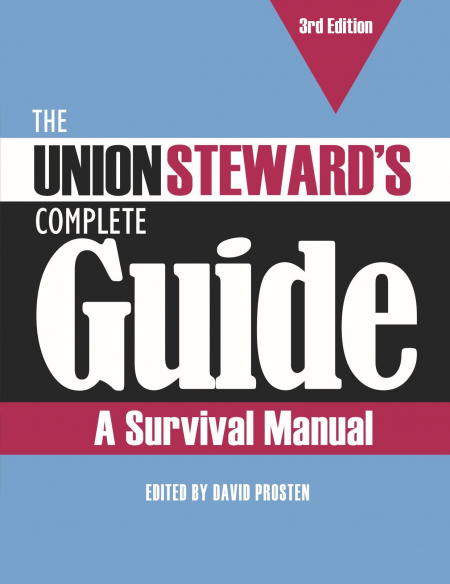Steward's Corner: Recruiting and Keeping Volunteers

Just as unions couldn’t function without stewards, unions also need member-volunteers to work on all sorts of committees, petition campaigns, direct actions, and more. Photo: Chelsea Bland, CC BY 2.0.
A tree is only as strong as its roots, and a union is only as strong as its actively involved members. Just as unions couldn’t function without stewards, unions also need member-volunteers to work on all sorts of committees, petition campaigns, direct actions, and more.
But the question is: How do you get members to volunteer their time, talents, and energy?
According to research on people who are active in social and political movements, the choice to get involved is based on three factors:
- The organization’s goal has to be important to people.
- People must believe that what they’re being asked to do will realistically lead to the achievement of that goal.
- People must believe that their participation is necessary for the action to lead to achievement of the goal.
There are no guaranteed ways to be sure these factors exist in any given situation, but there are some solid guidelines on the successful recruitment and retention of member-volunteers.
LISTENING
Union members will take on responsibility for their own reasons, not yours. But you need to know what their reasons are. And you find out by listening to them—face to face.
Use the 80/20 rule. Spend no more than 20 percent of your time talking, and at least 80 percent of your time listening. Such a conversation can take as little as 10 minutes at a break, at lunch, or before or after work.
For example, you listen to someone and find out that they care a lot about a safety issue. If this is something important to the union, you might ask them to investigate. You’re matching a need of the union with something the member cares about.
Asking people what they care about is like hanging out with a purpose. Ask open-ended questions—questions that cannot be answered just yes or no. For example: “How do you like working here? What do you think about this place? What do you think is not so good?” Pay attention and don’t interrupt. Hear them out. If they say something, but you think more is there, say, “Could you tell me a little more about what you mean?”
PAYOFFS
What are the needs that motivate members to give their time to union activities?
For some people it is a need to build or maintain a sense of self-esteem, to show off their creativity, or receive recognition for their contributions. For others, the desire to volunteer is rooted in a need for connection, a need to be with and accepted by other people who share common values. And for still other people it may be a belief that by volunteering, they are helping to ensure their job security or improve their wages and benefits. Whatever the need, it is important to make sure you understand it and be sure it is satisfied.
ASKING FOR HELP
The first step in recruiting volunteers is to ask for help. To be effective, recruitment needs to be personal—done face-to-face and one-on-one. And then, remember the following three points:
1. Ask people to do small, specific, manageable tasks with definite end points.
If a steward asked a member to help out by trying to get all her friends to come to the next union meeting, would she be likely to do it? Probably not. The task is too big and too vague—and she wouldn’t know where to start.
It’s better to ask the member to contact five people over the next two days and bring them to the meeting. Or, ask her to provide the names of five people for the steward to contact. She’d be much more likely to accept the assignment. Why? Because:
- The member doesn’t have to spend any time thinking about the task or making decisions about who to approach; you’ve already made the job simple and clear.
- The task you’re asking the member to undertake is relatively small and easy.
- The member will know when she’s done.
CHECKLIST FOR INVOLVING MEMBERS
- Appeal to their self-interest.
- Appeal for support of a larger cause.
- Remind potential volunteers of skills or experience they have to contribute.
- Be honest about the work involved.
- Recruit people from all subgroups.
- Start with specific, easy tasks, then gradually encourage greater involvement.
- Match volunteers to tasks based on their skills, interest, and time.
- Provide training for volunteers.
- Teach people how to get others to share the work.
- Make it fun to participate.
- Point out every small victory to prove that involvement pays off.
- Recognize the work that volunteers do.
- Check on people to see if they need help.
- Hold people accountable, and shift them to another assignment if the task isn’t getting done.
That last reason is fairly important. People need the sense of accomplishment that comes from finishing a task, no matter how small it is. Ideally, the task should have a number attached to it so people can measure their progress.
If you give members specific numbers of people to contact, for example, they’ll know when they’re halfway done—and how much remains. The experience has been pleasurable in that way. They’ve accomplished something, and may want to do it again.
2. If at all possible, give people a choice of tasks.
The person who hates calling members on the phone may not mind stuffing envelopes. The person who feels uncomfortable handing out leaflets may be great at writing a story for the newsletter. One person may want to be involved in decision making and planning the event, another may just want to be told what to do.
3. Reward people.
Maybe it sounds crude, but the fact is most people like to get paid for what they do, even volunteers. The payment may be the sense of pride from doing the right thing. Or for some, the payment could be public recognition and a thank you at a union meeting. Or getting their picture in the union newsletter. Or a free union jacket.
Instead of a perfunctory thank you to everyone who helped, spend some time thanking people individually.
Be specific. Tell each member how his or her work is contributing to the overall goal. People work harder if they understand how they’re helping, and that other people are depending on them for the success of the project.
RECRUITMENT SUGGESTIONS
If you’re asking a member to show up for the first time, or to do a task that’s unfamiliar, you need to be present at that activity yourself. Your presence allows the volunteer to see someone familiar and allows you to demonstrate the kind of behaviors you want others to follow.
Encourage member-volunteers to ask questions of you. This is especially important if what they are being asked to do is new or unfamiliar to them. Knowing that they can ask questions offers them reassurance and builds their confidence.
If you think it will help, don’t hesitate to tell the member who else will be helping with the project. For some people it is the social relationships that inspire their desire to volunteer their time and talent.
Have confidence in your ability to recruit volunteers. Be persuasive and turn “maybe” into a definite commitment. Don’t take no for an answer without asking for a reason. And if you get a firm no, don’t take it personally; let the volunteer know that you will miss his help and that you will be asking for help again.
Provide members with the training and necessary tools to successfully accomplish the task. Nothing succeeds like success, and if you don’t provide the right training or tools you are setting yourself up for a one-time-only volunteer.
Keep in touch with the member as the task moves toward completion. Check to see how it is progressing. This helps you find problems as they appear and allows you to recognize the member’s contributions as they occur. It also lets the member know that you will be holding her accountable for her work.
Allow member-volunteers to develop a sense of ownership. Make them a part of the planning process; ask for ideas and opinions. Let them have a real voice in shaping decisions.
Recognize and find ways to reward the contributions that the members make. Reinforcing good work helps people want to contribute again.
And finally, keep records on the volunteers. Note which projects they worked on and how much time they contributed. Keep track of the members’ skills and note any new ones that may have been acquired as a result of union projects. This way you can build a member-volunteer bank, which will come in handy the next time an important union project comes up.
From The Union Steward’s Complete Guide: A Survival Manual, 3rd Edition. Edited by David Prosten. Available at labornotes.org/store. For bulk purchases, visit davidprostenbooks.com.

SUPPORT LABOR NOTES
BECOME A MONTHLY DONOR
Give $10 a month or more and get our "Fight the Boss, Build the Union" T-shirt.




